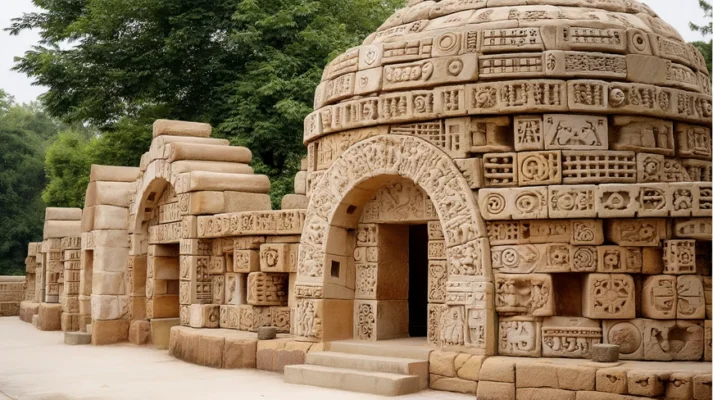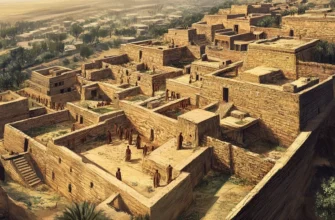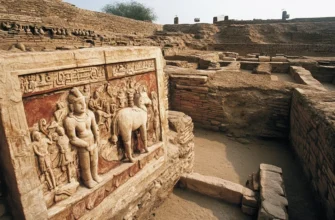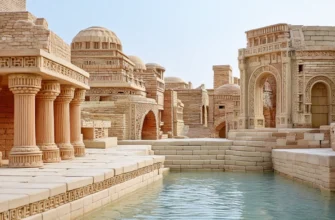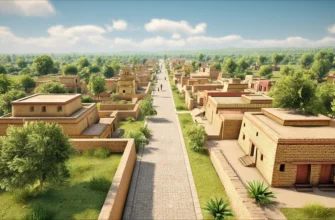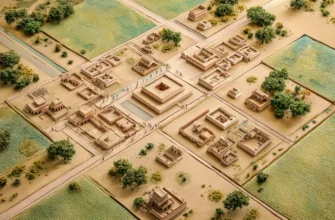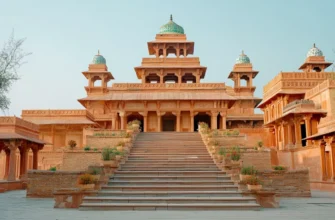Pataliputra, modern Patna, was an important city in ancient India that played a central role in the development of the country’s political, cultural, and economic life. Located on the banks of the Ganges River, the city became the capital of several great empires, including the Mauryan dynasty and the Gupta Empire.
Founded as a military post during the Nanda dynasty, Pataliputra quickly became a political and cultural center. During the reign of Ashoka the Great, Pataliputra became one of the largest and most developed urban centers of the ancient world. The city became a center of scientific research, art, and religious thought. It is known for its architectural monuments, including palaces and temples, as well as its developed infrastructure.
Pataliputra was also an important economic center due to its strategic location on trade routes. Numerous trade routes connecting India with other parts of Asia intersected here.
Thanks to its influence and historical significance, Pataliputra has left a deep mark on Indian history. Today, the city stands as a testament to the grandeur and cultural richness of India’s ancient civilization.
Foundation of the city and its geographical location
Pataliputra was founded in the 4th century BC as a strategic military post during the reign of the Nanda dynasty and eventually became an important political and cultural center. The city was located on the site of modern Patna, in northeastern India, on the banks of the Ganges River.
Its geographical position at the crossroads of important trade routes made Pataliputra a convenient place for the development of trade and contributed to its growth as a center of administrative and military power.
This city was of strategic importance because it was located in the heart of the Indian subcontinent, which made it easy to control important territories in eastern and western India. The Ganges River, which ran through the city, provided waterways for the transportation of goods and was also the main source of water supply.
Thanks to this location, Pataliputra quickly became one of the largest and richest cities of ancient India, playing an important role in the development of the country’s cultural, political, and economic spheres.
Pataliputra during the Maurya dynasty
Pataliputra became the center of political power during the Maurya dynasty, which began in the late 4th century BCE after Chandragupta Maurya founded the Maurya Empire. He made Pataliputra the capital of his vast state, which covered significant parts of the Indian subcontinent.
During the reign of Chandragupta and then his son, Ashoka the Great, Pataliputra experienced a period of incredible prosperity. The city became not only a political but also a cultural and economic center. The empire’s administration was concentrated here, which was an important factor in the centralization of power. Pataliputra controlled large territories stretching from the southern regions to the northern areas of India.
During the reign of Ashoka, the city became an important center of Buddhism, as Ashoka actively promoted the spread of this religion throughout the empire. He built numerous Buddhist monasteries, temples, and steles with edicts that set out the basic principles of Buddhism and the emperor’s moral precepts. It was also a time of great achievements in architecture and urban planning: Pataliputra became an important city with a well-developed infrastructure, including palaces, temples, and aqueducts.
The influence of Pataliputra during the Mauryan period was great not only within India but also far beyond its borders. The city became an important commercial and diplomatic center, attracting the attention of many other countries and peoples of the time.
Pataliputra during the Gupta Empire
After the decline of the Mauryan Empire, Pataliputra remained an important city, but its role changed significantly during the reign of the Gupta dynasty (4th-6th centuries AD).
The Gupta Empire, often referred to as the “Golden Age of India,” brought a new flourishing of culture, science, and art, and Pataliputra once again became one of the major centers of this period.
Although Pataliputra was no longer the capital of the empire at this time (which became Ujjain), the city remained an important administrative, commercial, and cultural center. During the Gupta period, Pataliputra retained its strategic importance due to its location at the crossroads of trade routes, which allowed it to maintain links with other important cities and countries. The trade routes passing through Pataliputra contributed to the development of the economy and ensured the prosperity of the city.
The cultural development of Pataliputra during the Gupta period was also at a high level. The city became an important center for science and education, particularly for the development of Indian astronomy, mathematics, philosophy, and art. Famous scholars such as Varga worked during this period, and it was in Pataliputra and other Gupta cities that the intellectual elite was formed. Buddhist monasteries and other educational institutions that supported knowledge and research played a huge role in this.
During the Gupta reign, the city’s architecture also underwent changes. New temples and palaces were built, reflecting the achievements of the time in art and construction. Pataliputra was home to numerous cultural monuments and became an important center for creativity and religious activity.
Thus, although Pataliputra was not the capital during the Gupta Empire, it continued to be an important center of political, cultural, and economic life, contributing to the development of India during this period.
Cultural and architectural development of Pataliputra
As an important cultural and political center of ancient India, Pataliputra experienced periods of significant development in culture and architecture, especially during the reign of the Mauryas and Guptas.
Cultural development:
Science and education: Pataliputra was a center of intellectual life. Great scholars and philosophers worked in the city, and numerous libraries and educational institutions became important centers of knowledge. During the Mauryan Empire, Pataliputra became an important place for the development of Buddhism and other religious philosophies, as well as science, particularly astronomy and medicine. During the Gupta period, the city became important for the development of mathematics and astronomy, and it was during this period that the foundations of modern Indian scientific concepts, such as the decimal system of numerals, were laid.
Art and literature: Pataliputra became an important center for the development of art, literature, and theater. The city became a place where numerous literary works, poems, and religious texts were created. Famous artists created statues of gods, including Buddhist and Hindu images, which have been preserved in archaeological excavations to this day.
Religion and philosophy: Pataliputra was an important religious center. During the reign of Ashoka, the city became a place of Buddhist propagation, and numerous monasteries and temples were built here. Religious rituals and festivals in Pataliputra were part of the daily life of its inhabitants.
Architectural development:
Urban planning and infrastructure: Pataliputra was located at an important crossroads of trade routes, so its architectural planning was aimed at ensuring efficient trade and transport. The city had a developed network of roads, irrigation and water supply channels, as well as palaces, markets, and residential areas. The Ganges River was of great importance for the city’s development, providing it with water and serving as an important transport artery.
Temples and palaces: The architecture of Pataliputra was rich in religious and secular buildings. Huge palaces were built in the city to serve the rulers, as well as temples that reflected the religious beliefs of the time. During the Mauryan and Gupta periods, magnificent Buddhist temples, steles with Ashoka’s edicts, and Hindu shrines appeared in Pataliputra. Of particular note is the construction of stone statues and reliefs, which became iconic for Indian art.
Sculpture and decorative elements: The architectural monuments of Pataliputra were decorated with magnificent sculptures. Particular attention was paid to the decoration of temples, statues of deities, and reliefs on the walls of buildings. The city was also famous for its decorative elements in the interiors of palaces and public buildings.
Thus, the cultural and architectural development of Pataliputra contributed to the creation of a city that became not only a political but also a major center of cultural life in ancient India. The development of science, art, religion, and architecture made Pataliputra an important center of intellectual and spiritual development in India at that time.
Economy and trade in Pataliputra
Located at the crossroads of important trade routes, Pataliputra was not only a political and cultural center but also an important economic hub of ancient India. Thanks to its strategic location, the city became an important trade and commercial center, which contributed to the prosperity of the economy during the reign of the Mauryan and Gupta dynasties.
Trade routes and strategic location:
Pataliputra was located at an important crossroads of land and water trade routes.
The Ganges River, which flowed through the city, provided transport links to other regions of India, as well as to neighboring countries such as modern Bangladesh, Nepal, and even parts of the Middle East. This made Pataliputra an important stop for merchants transporting goods across India.
The city maintained ties with other important cities in India and with countries beyond its borders, such as Persia, Egypt, and Central Asia. This contributed to the development of not only domestic but also international trade.
Main goods and crafts:
Trade in Pataliputra covered a wide range of goods.
Among the main export goods were:
Agricultural products: in particular, rice, wheat, spices (cardamom, pepper), cotton, and other crops.
Metal goods: Pataliputra was known for its metalwork, especially steel and other metals.
Textiles and precious materials: Indian textiles, especially cotton and silk, were very popular in foreign markets. In addition, Indian jewelers made gold and silver jewelry, which was exported to other parts of the world.
Crafts and arts: Pataliputra was also known for its art, including statues of deities and artistic items made of glass, wood, and stone.
Development of economic infrastructure:
Pataliputra’s infrastructure was developed thanks to numerous government initiatives that promoted economic development. The construction of roads, bridges, and canals to facilitate the transportation of goods was an important part of the city’s infrastructure. This reduced transportation costs and promoted trade.
The city also had a well-organized system of markets where merchants from different parts of India and foreign traders could exchange their goods. Pataliputra was an important center for the exchange of cultural and economic ideas.
Tax system and administration:
The economy of Pataliputra was also supported by a developed tax system. The Mauryan and then Gupta empires levied taxes on merchants and landowners, which allowed them to finance large public projects and military campaigns. All these funds were used to develop infrastructure, support the army, and improve the lives of citizens.
Impact of trade on neighboring regions:
Thanks to Pataliputra, India became an important player on the world’s trade routes. Traders and merchants who came to Pataliputra brought not only goods to the city, but also ideas, technologies, and cultural influences from other parts of the world, such as Persia, Rome, China, and the Middle East.
Thus, the economy and trade in Pataliputra became important components of its prosperity. The city became an important center not only of political and cultural activity, but also of economic activity, which allowed it to remain one of the main centers of ancient India.
The legacy of Pataliputra and its significance in Indian history
Although Pataliputra lost its political significance after the decline of the Mauryan Empire, it left a deep mark on Indian history. As an important cultural, scientific, religious, and economic center, this city became the foundation for the development of numerous aspects of Indian civilization that had a great influence on the following centuries. The legacy of Pataliputra largely determined not only the historical processes of India, but also its cultural ties with other parts of the world.
Cultural heritage:
Pataliputra was an important cultural center. The city became a place for the development of Indian literature, science, and art, which left their mark on subsequent stages of Indian history. Thanks to this, Pataliputra became one of the main centers of Indian culture. It was not only a center for scholars and artists, but also a place where tradition and knowledge were preserved and passed on. Over the centuries, this city became a symbol of the flourishing of intellectual activity, particularly in science and philosophy.
Religious significance:
During the reign of Ashoka the Great, Pataliputra became an important religious center, especially for Buddhism. After converting to Buddhism, Ashoka actively promoted this religion within his empire, and Pataliputra became a place for the spread of Buddhist teachings.
Numerous Buddhist monasteries, temples, and steles with edicts containing the emperor’s moral precepts were built here. Pataliputra thus became an important center of religious and cultural influence on other countries in South Asia.
Scientific heritage:
Pataliputra was known for its intellectual atmosphere. Scholars from all over India and beyond came here to exchange ideas. The city became a center for the development of astronomy, mathematics, medicine, and philosophy. This laid the foundation for the development of Indian scientific thought in the following centuries. Theoretical achievements such as the decimal number system, which was spread through Pataliputra, are among India’s greatest scientific legacies.
Political significance:
Pataliputra was a symbol of India’s political power during the reign of the Mauryan dynasty. As the capital of India’s most powerful empire, it became the center of government, ensuring political stability in a vast region. The city was not only an administrative center but also an important place for diplomatic relations, as it hosted important meetings and negotiations with other states.
Archaeological and architectural heritage:
Excavations in Pataliputra show that the city was not only an important cultural and political center, but also an important architectural achievement of its time. Palaces, temples, steles, and other architectural monuments, including statues and reliefs, are evidence of the high level of Indian construction.
Many of these archaeological finds help modern researchers reconstruct life in the ancient city.
Influence on other cultures:
Through its role in trade, religion, and science, Pataliputra influenced cultural and economic processes not only in India but also in other parts of Asia. The city became an important link in global trade and cultural exchanges, maintaining ties with regions such as Persia, China, and even the Roman Empire.
The legacy of Pataliputra has had a profound impact on the development of India, and its importance as a cultural, scientific, and political center cannot be overstated. This city became the foundation for many of India’s achievements in various fields, and its role in the development of civilization can still be felt today.
Conclusions
Pataliputra was one of the largest and most influential cities of ancient India, playing a key role in the development of political, cultural, religious, and economic processes on the Indian subcontinent. The city became an important political center, being the capital of the largest Indian empires, including the Mauryan Empire and, partially, the Gupta Empire. It became a symbol of centralization of power and political stability across the vast territory of India.
Pataliputra was also a cultural center where science, art, and literature flourished. The city became a place where great scientific and philosophical works were created that influenced all of India and even other parts of the world. During the reign of Ashoka, Pataliputra was also an important religious center where Buddhism was actively promoted.
The city became a center of religious reflection and practice, as well as a place for the spread of Buddhism to other territories. The economic importance of Pataliputra cannot be overestimated, as the city’s strategic location made it an important trading center, contributing to India’s prosperity and maintaining ties with other cultures and countries.
The architectural heritage of Pataliputra is also an important part of its history. Huge palaces, temples, statues, and other architectural monuments have become part of India’s cultural heritage and left a deep mark on the development of Indian art.
Thus, Pataliputra was an important stage in the history of India, where political, cultural, and economic processes interacted and determined the further development of the country. The legacy of this city not only left a deep mark on Indian civilization but also influenced world history, particularly in the fields of science, culture, and religion.
